员工敬业度的英文文献综述
- 格式:docx
- 大小:9.54 KB
- 文档页数:8
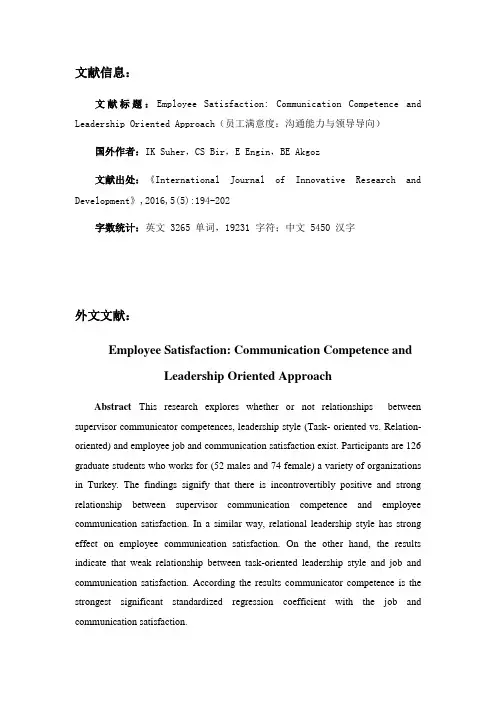
文献信息:文献标题:Employee Satisfaction: Communication Competence and Leadership Oriented Approach(员工满意度:沟通能力与领导导向)国外作者:IK Suher,CS Bir,E Engin,BE Akgoz文献出处:《International Journal of Innovative Research and Development》,2016,5(5):194-202字数统计:英文 3265 单词,19231 字符;中文 5450 汉字外文文献:Employee Satisfaction: Communication Competence andLeadership Oriented ApproachAbstract This research explores whether or not relationships between supervisor communicator competences, leadership style (Task- oriented vs. Relation- oriented) and employee job and communication satisfaction exist. Participants are 126 graduate students who works for (52 males and 74 female) a variety of organizations in Turkey. The findings signify that there is incontrovertibly positive and strong relationship between supervisor communication competence and employee communication satisfaction. In a similar way, relational leadership style has strong effect on employee communication satisfaction. On the other hand, the results indicate that weak relationship between task-oriented leadership style and job and communication satisfaction. According the results communicator competence is the strongest significant standardized regression coefficient with the job and communication satisfaction.Keywords: Employee communication, communication competence, leadership style1.IntroductionEmployee satisfaction influence an individual's commitment to the company and also it has effect on employee performance and business success. Employee behavior and satisfaction are highly correlated to the organization success and because of this reason the researches on employee satisfaction is quite rich. Pincus (1986) investigated the effect of communication satisfaction on job performance, Helm (2011) studied about employees’ impact on corporate reputation, Cravens and Oliver (2006) mentioned employees as key factor of reputation, Antoncic and Antoncic (2011) and Duboff and Heaton (1999) specified how employee satisfaction is important on business growth, Bulgarella (2005), Hanna at all. (2004) remarked that employee satisfaction is a vital aspect for customer satisfaction, Brown et al. (1996) found out that positive employee behavior has strong and positive effect on customer satisfaction. Kattara et al. (2014) published a study about impact of employee behavior on customers' overall satisfaction.Employee satisfaction contains both communication and job satisfaction and it is influenced by many different factors like leadership style and the quality of communication with leaders. Increasing the effectiveness of leader-employee communication can help to strengthen levels of employee satisfaction.2.Literature Reviewmunication CompetenceCommunication competence is about the knowledge and wisdom of using applicable communication skills. Communication competence is not justunderstanding proper communication skills but also the ability to apply and adapt that knowledge when certain situations may emerge unexpected (Cooley and Roacch, 1984:25). Communication competence is considered to contain both cognitive and behavioral aspects (Rubin, 1985). Understanding that communication competence contains these two aspects, then being socially informed and perceptive is a key factor in being a competent communicator. Light (1989) considered fundamental constructs of communication competence as functionality of communication; sufficiency of communication, knowledge, judgment and skill. Spitzberg (1983) believed that communication competence involved knowledge, motivation and skill as a system that relates and connects to one another. In order to be mutually beneficent to one another in a relationship, communication competence is a necessary tool which consists of cognitive, attitudinal, emotional and behavioral knowledge (B-Ikeguchi, 2014). In order to reach personal, educational, vocational and social goals, communication competence is a key quality that an individual need in order to attain success in life (Light and Mcnughton, 2014:1).2.2.LeadershipYukl defined leadership as “the process of influencing others to understand and agree about what needs to be done and how to do it, and the process of facilitating individual and collective efforts to accomplish shared objectives” (2016:8). Leadership is not just a trait, it is recognized as a process which individuals influence people in order to reach certain goals and objectives as a unit (Sharmai, Jain, 2013). Bryman (1992) considered leadership as the ability to direct people towards certain goals for an organization.In literature, leadership is considered to be divided into two separate functions; Task- oriented leadership and relation-oriented leadership (Taberner, Chambel, Arana, 2009). Task-oriented leadership focuses on organizing, planning and coordinating the necessary jobs needed of the team or individual employees whereas relation-oriented leadership focuses on the motivation and behaviors of the people themselves. Inrelation-oriented leadership, the leader works to inspire those around him in order to achieve the organization’s success. The effectiveness of leader-subordinate relationship affects many organization outcomes due to group satisfaction (Anderson, Madlock& Hoffman, 2006). Leadership plays a great roll in effecting employee satisfaction (Castaneda &Nahavand, 1991).munication SatisfactionCommunication satisfaction is an important topic in our day which is being researched and investigated for business and communication industries. “Communication satisfaction is a n employee's satisfaction with various communication practices of the organization” (Clampitt and Girard, 1993:84). Pincus described communication satisfaction as the accumulation of an individual’s satisfaction which is saturated from information flow and relationship variables (Pincus, 1986). Different researches has studied on communication satisfaction measurement. For instance, Downs and Hazen (1977) created Communication Satisfaction Questionnaire, Organizational Communication Scale was conducted by R oberts and O’Reilly (1979), and to analyze communication practices in organizations. Crino and White (1981) were the researchers who offered a conceptualization of communication satisfaction.A conceptualization of communication satisfaction was offered by Crino and White (1981), who argued that organizational communication satisfaction involves an individual’s satisfaction with various aspects of the communication occurring in the organization, whereas Putti, Aryee, and Phua (1990) demonstrated that organizational members’ communication satisfaction is associated with the amount of information available to them. Although communication provides employees with information that clarifies work tasks and may contribute to communication satisfaction, Anderson and Martin (1995) found that employees engage in communication interactions with coworkers and superiors to satisfy interpersonal needs of pleasure and inclusion. Thus, employee communication satisfaction appears to involve a task and relationaldimension.2.4.Job SatisfactionJob satisfaction has been an area which examined by researchers for a long time. According to Locke (1976) definition job satisfaction is a pleasant or positive emotional expression which causes by worker’s job or job expe rience.Many different researches have shown that dissatisfied employees are more likely to quit their jobs or be absent than satisfied employees so job satisfaction is one of the vital necessaries for business success (Saari and Judge, 2004). According to Schneider and Snyder’s definition (1975) job satisfaction is personal evaluation of conditions related to job, or outcomes that arise as a result of having a job. The perception of employees about their job is influenced by many different factors such as employee’s personal circumstances like needs, values and expectations (Sempane at al. 2002). Moreover, quality of communication in the organization, communication between employees and supervisors and supervisor leadership style have an influence on the em ployees’ job satisfaction.3.MethodThis research explores if relationships exist between supervisor communicator competence, leadership style (task or relationship oriented) an employee job and communication satisfaction in Turkey.The current researc h conducted based on the Mudlock’s article (2008) that titled “The Link Between Leadershıp Style, Communicator Competence and Employee Satısfaction” The research process which used by Mudlock (2008) contained four different scales to investigate relationship between components. Authors reached the original publications which contain the scale items and these scales translated to Turkish by authors and the pilot questionnaire was send 10 participants. The results of this pilot were used to refine the questionnaire for distribution to research participants.The data used in this study were collected from graduate students of Bahcesehir University in Turkey. Respondents were chosen by using the convenience sampling method.These participants are not only graduate students of Marketing Communication and Public Relations program but also they work for different organizations. The survey was pre-tested on 10 students and then a total of 200 questionnaire forms send them via e-mail. At the end of the given period 126 usable questionnaire forms returned.Communicator competence scaled was developed by Monge et al. (1982.9) which is 12-item Communicator Competence Questionnaire. Job satisfaction was measured by the 8-item Abridged Job in General (AJIG) scale (Russell et al., 2004). Communication satisfaction was measured by the 19-item Interpersonal Communication Satisfaction Inventory (ICSI) developed by Hecht (1978). Leadership style was measured by the 20-item Leadership Style Questionnaire developed by Northouse (2001). The instrument measures the task and relational leadership s tyles.Mudlock (2008) used Pearson correlations and multiple regression analyses to show relationship between predictor and criterion variables. In the current research we followed his way to test hypotheses and to answer two different research questions.The current research has the same hypotheses and research question in Mudlock’s (2008) article. These are:H 1: There is a significant and positive relationship between supervisor communication competence and employee job and communication satisfaction.H 2: There is a significant and positive relationship between supervisor relational leadership style and employee job and communication satisfaction.H 3: There is a significant and positive relationship between a supervisor’s task leadership style and employee job and communication satisfaction.H 4: There is a significant and positive relationship between a supervisor’s task and relational leadership style and communication competence.RQ1: Which behavior displayed by a supervisor—task leadership, relational leadership, or communicator competence—will serve as a greater predictor of employee communication satisfaction?RQ2: Which behavior displayed by a supervisor—task leadership, relational leadership, or communicator competence—will serve as a greater predictor of employee job satisfaction?4.FindingsParticipants were 126 working adults and more than half were female (see table 1). Table 3 shows organizations which they work for. 43 participants were working for a female supervisor and 79 were working for a male supervisor. (see table 2) Participants ranged in age from <= 25 to 41+ (M = 30.44, SD = 16), whereas supervisors’ ages ranged from 30 to 71 (M = 48,70 SD = 12.7). Table 3 contains information about participant’s organizations types.Table 1: Sex of ParticipantsTable 2: The Sex of SupervisorTable 3: Organizations of ParticipantsTable 4 shows questionnaire items and the mean scores of communicator competence. Cronbach’s alpha for the current study is 0.809 and the dimension mean is 3.13.Table 4: Communication SatisfactionTable 5 contains items and mean score related to job satisfaction. Cronbach’s alpha for the current study was 0.787 (see table 5).Table 5: Job SatisfactionCommunication satisfaction scale items and the mean scores may be seen in the table 6. Cronbach’s alpha for the current study is 0.800 and the dimension mean is 3.53.Table 6: Communicator CompetenceLeadership style was measured by the 20-item Leadership Style Questionnaire. Originally this scale has 20 different items to evaluate leadership style. 10 of 20 items are related to task-oriented style while the others are related to relationship-oriented style. In this research we used one scale to measure leadership style but below we used two different tables to show task-oriented and relationship- oriented items’ mean scores and Cronbach’s alpha results.Table 7: Leadership Style (Task)Table 8: Leadership Style (relationship)The first hypothesis was there would be significant and positive relationships between supervisor communication competence and employee job and communication satisfaction. Pearson correlations supported the hypothesis by indicating statistically significant positive relationships between the predictor and criterion variables. The relationship between communication competence and communication satisfaction was stronger than the relationship between communication competence and job satisfaction.The second hypothesis predicted significant and positive relationships between supervisor relational leadership style and employee job and communication satisfaction Pearson correlations supported the hypothesis. The relationship between supervisor relational leadership style and employee communication satisfaction was strong while the relationship between supervisor relational leadership style and employee job satisfaction weak.The third hypothesis suggested significant and positive relationships between supervisor task leadership style and employee job and communication satisfaction. Pearson correlations supported the hypothesis. However, both relationships were weak.The fourth hypothesis was there would be significant and positive relationshipsbetween supervisors’ task and relational leadership style and their communicator competence. Pearson correlations supported the hypothesis. For both components the relationships were strong.5.DiscussionNowadays, the most important attribute that corporations may possess is regarded as their employees. Establishing effective communication with the employees considered as an integral part of the entire in-house process and operation depends on the communication competence of the leader. When the leader establishes efficient communication between the employees, it will be deemed as having taken an important step for determining and eliminating the problematic areas and problems encountered by the corporation.The satisfaction of the employees about their job and communication is significant for fulfilling corporate objectives. Two of these basic aspects which affect this satisfaction level are the leadership style demonstrated by the executives and communication component.The communication established with the employees has numerous significant functions. These may be listed as acquiring information, persuasion and influence, providing instructions and combination with education-training. Communication component possessed by the leader has a key role in fulfilling these functions in a healthy manner because this competence constitutes one of the milestones for the formation of mutually satisfactory relationships with the employee. Apart from the communication competence of the executive, it is also indicated that his leadership approach affects the employee's communication and job satisfaction.Mudlock (2008) previously examined the relationship between communication competence, leadership style and employee communication and job satisfaction in a research that he had conducted and determined that there is a strong and positivecorrelation between these. This current research is also derived from Mudlock’s study and tests the same hypotheses in Turkey obtaining similar results in the end.According to these results, the relationship between communication competence and communication satisfaction is strong. This statistically significant and positive relationship demonstrates that it is of vital importance for supervisors to develop their communication competences and transform these competences into an integral part of their leadership styles.It has been concluded that the supervisor communication component has a positive impact on the job satisfaction of the employees even though it is not as strong as communication satisfaction. Employee communication and job satisfaction both have a key significance in the performance of both in-house and outside targets of the corporation, ensuring market growth, increasing customer satisfaction levels, increasing sales figures and creating a strong and positive corporate reputation. For this reasons, executives are required to show the necessary efforts to develop their communication competences. It is obvious that the communication competence is one of the determinant factors on task and relational oriented leadership styles.In this study, it has been concluded that the relationship between supervisor relational leadership style and employee communication satisfaction was strong. Relational leadership style refers to placing the relationship established with other people to the core while acting as a leader and the right management of relationships. In this regard, executives concentrating on their relational leadership skills while developing their communication components would bear positive results.Task-oriented leadership style places emphases on obtaining suitable business methods and careful inspection of group members for the success of the business. The communication channels used by the corporation between the leader and group members is only related to the activation of the structure and obtaining results (Bloisit et al., 2003:574). Therefore, as a task-oriented leader only evaluates the task performance of its employees, it does not have a directly statistically significantimpact on the job and communication satisfaction of the employee. As the supervisor cannot establish effective communication to develop any kind of relationship, it is natural for the relationship with the communication satisfaction of the employees to yield weak results.In conclusion, this research demonstrates that the leader's communication competences and at the same time, relational leadership style have a positive impact to ensure employee satisfaction and in this regard, it provides a guidance to the corporations which would like to concentrate on satisfaction that they have to develop the quality of communication and support relational leadership approach.中文译文:员工满意度:沟通能力与领导导向摘要本研究探讨了主管沟通能力、领导风格(任务型与关系型)与员工工作及沟通满意度之间是否存在关系。
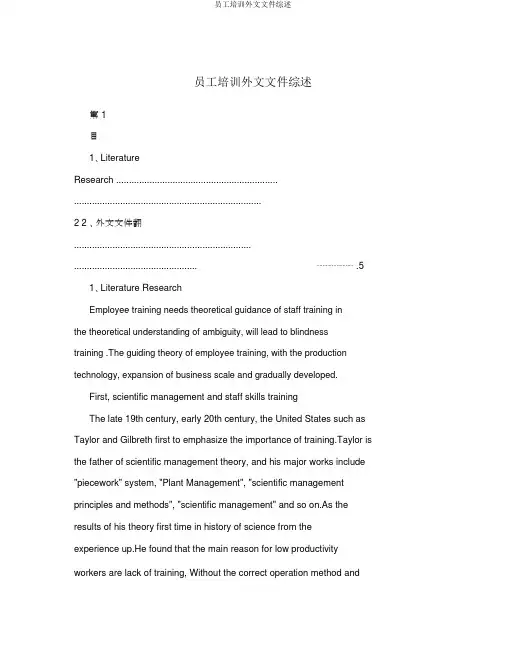
员工培训外文文件综述第 1目1、LiteratureResearch ............................................................... .........................................................................2 2 、外文文件翻..................................................................... ................................................⋯⋯⋯⋯⋯⋯⋯⋯ .51、Literature ResearchEmployee training needs theoretical guidance of staff training inthe theoretical understanding of ambiguity, will lead to blindnesstraining .The guiding theory of employee training, with the production technology, expansion of business scale and gradually developed.First, scientific management and staff skills trainingThe late 19th century, early 20th century, the United States such as Taylor and Gilbreth first to emphasize the importance of training.Taylor is the father of scientific management theory, and his major works include "piecework" system, "Plant Management", "scientific management principles and methods", "scientific management" and so on.As the results of his theory first time in history of science from theexperience up.He found that the main reason for low productivity workers are lack of training, Without the correct operation method andapplication of tools, so he carried a lot of tests in the factory. Healso studied tools, machinery, materials and standardization of the work environment, and the basis of these findings to develop more scientific work day fixed, and the completion of these fixed, standardized tools.Gilbreth also shoot video with the method of recording and analyzing the operation of the workers movement, to find the best reasonable action to improve efficiency.This time they are through the use of research, action research methods to made standard operating method, according to this standard method to train workers.Taylor said: first-class workers are not fall from the sky, is trained by scientific training, and in the past, the training is his thing, by their own plans, their implementation, and now, training is something the factory, the specialized agencies and staff, to make standardized tools and standardized methods of operation complete control by the workers, it must be systematic, scientific training, we must take the workers one by one by a qualified teacher, with the new operating practices to train until the workers are able to continuously and used to operate in accordance with scientific rules ("Principles of Scientific Management").Taylor and Gilbreth and others from the research can be seen, with their emphasis on training is the training of staff operating skills.Second, behavioral science theory and the attitude of staff trainingScientific management theories that focus on aspects of the production process, the human body as a machine accessories, arousedstrong resentment among the workers, so some scholars began to physiology, psychology, sociology and so starting to study the human enterprise work motivation, emotion, behavior and the relationship between work and so on, so how in accordance with the laws ofhuman psychological development to stimulate their enthusiasm and creativity of the behavioral sciences is adopted.30 years of the 20th century, the United States in the WesternElectric Company psychologist Mayo's Hawthorne plant belongs, for the determination of various factors on the degree of production efficiencyof thelast eight years, a series of tests, this is the famous Hawthorne Experiment .The experiment, Mayo and others found that: the working environment, working conditions, good or bad as people are notexpected to affect workers as labor productivity; people are "social" and, therefore, staff morale, job satisfaction, can be appreciated is also an important factor affecting labor productivity.In 1943, the famous American psychologist Maslow proposed "hierarchy of needs" that: human needs can be divided into five levels: (1) physiological needs; (2) safety needs; (3) the feeling of belonging; (4) respected; (5) self-realization.These five requirements are based on (1)to (5) from low to high order, and under normal circumstances, onlyin the lower level needs are met before to meet higher level needs.attitude, emotional, demand will affect the level of productivity gains, therefore, focus on skills training to employees after the theory in the behavioral sciences under the guidance of staff training to enhance knowledge, skills training, while more and more attention the attitudeof the staff training.Focus on training staff on the proper values,corporate philosophy, positive work attitude, good habits, and thepursuit of higher goals.Thus, training to become a specializedprofession, training content, constantly deepening and expanding.Since the 60s of the 20th century, people began to study theleadership style of management satisfaction with the relationshipbetween workers, making the lower staff training from a focus on staff training to focus more on the changes on the training of managers.Third, knowledge management and staff learning, innovation training 2l century is the era of knowledge economy, knowledge-based economy is built on the basis of knowledge and information economy, knowledge and information based on the production, distribution and use of thedirect basis of the economy, knowledge is to improve the productivity and economic growth.And the knowledge economy corresponding to the management theory is knowledge management, knowledge management is a knowledge resource for institutional information and the systematic management of science.The practice of knowledge management work generally consists of three aspects: (1) through the establishment of institutional knowledge base and set the body of knowledge managers need to master the knowledge and the systematic collection of resources,filtering, sorting, storage, to new knowledge in order to extract organization personnel at any time and apply them to practical work and learning; (2) to promote the exchange of knowledge within the organization and sharing, and communication process with the new knowledge resources to conduct precipitated into the body of knowledge library; (3) personalized tool to helpcustomize the management of personnel within the organization specific knowledge resources required to improve the efficiency ofwork and study, and to facilitate personal knowledge management.Era of knowledge economy, knowledge to the average 5-year aging cycle for each individual business, only continuous learning, innovation is the only way out, a lot of business decision-makers are concerned about whether their company has such a capability.Bideshengji's "The Fifth Discipline," a book stressed: "Only by learning the business will be competitive," "You have to learn than your competitors, faster."So it proposed the establishment of "learning organization."The development of information technology provides a powerful knowledge management tool, knowledge management is to create a platform for learning organizations.Learning organization is a stable platform for developing creative talent and organizational security.Because, in the era of knowledge management, the significance of employee trainingis learning ability and creative ability of the training, the ultimate goal of training is to form a self ranging from under a full learning culture.In summary, the guiding theory of corporate training experience,from scientific management to knowledge management, behavioralscience and then to the three stages of staff training has also gone through training from skills training to approach and then to learning,innovation training, three processes, factors that promote this development process the technology's progress and expansion of business scale and economy of development.2、外文文件翻译公司员工的培训工作需要必定的理论作指导,在理论上对员工培训工作认识含糊,会致使培训工作的盲目性。
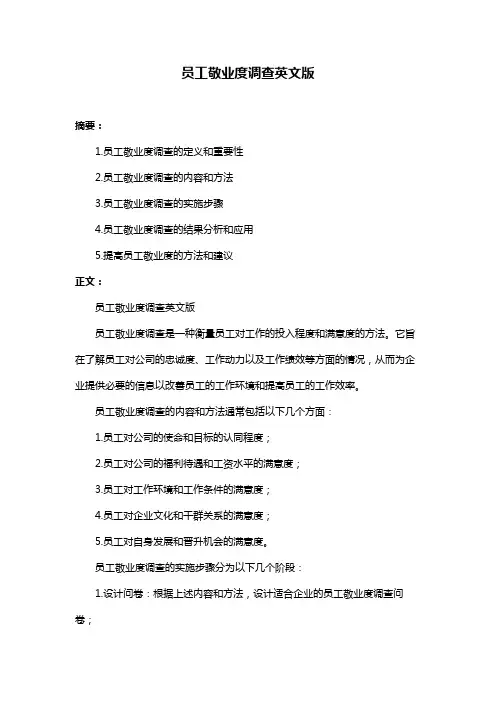
员工敬业度调查英文版摘要:1.员工敬业度调查的定义和重要性2.员工敬业度调查的内容和方法3.员工敬业度调查的实施步骤4.员工敬业度调查的结果分析和应用5.提高员工敬业度的方法和建议正文:员工敬业度调查英文版员工敬业度调查是一种衡量员工对工作的投入程度和满意度的方法。
它旨在了解员工对公司的忠诚度、工作动力以及工作绩效等方面的情况,从而为企业提供必要的信息以改善员工的工作环境和提高员工的工作效率。
员工敬业度调查的内容和方法通常包括以下几个方面:1.员工对公司的使命和目标的认同程度;2.员工对公司的福利待遇和工资水平的满意度;3.员工对工作环境和工作条件的满意度;4.员工对企业文化和干群关系的满意度;5.员工对自身发展和晋升机会的满意度。
员工敬业度调查的实施步骤分为以下几个阶段:1.设计问卷:根据上述内容和方法,设计适合企业的员工敬业度调查问卷;2.发放问卷:将问卷发放给所有员工,确保每个员工都有机会参与调查;3.收集问卷:在规定时间内收集所有员工填写的问卷;4.数据分析:对收集到的数据进行统计和分析,得出员工敬业度的得分和相关结论;5.结果反馈:将分析结果反馈给企业高层,以便制定相应的改进措施。
员工敬业度调查的结果分析和应用对于企业来说至关重要。
通过分析调查结果,企业可以了解到员工对公司的满意程度和忠诚度,找出工作中存在的问题和改进空间,从而制定相应的改进措施和培训计划。
此外,企业还可以根据员工敬业度的得分来评估员工的工作绩效,为员工晋升和奖励提供依据。
提高员工敬业度的方法和建议包括以下几点:1.提供良好的工作环境和条件,包括舒适的办公空间、合理的工作时间和合理的劳动强度;2.提供合理的薪酬待遇和福利,确保员工的努力得到应有的回报;3.建立良好的企业文化,包括积极向上的工作氛围、公平公正的干群关系以及开放透明的沟通机制;4.为员工提供培训和发展机会,帮助员工提高自身能力和实现职业成长;5.关注员工的个人需求和情感关怀,建立有效的员工关怀机制,提高员工的归属感和忠诚度。
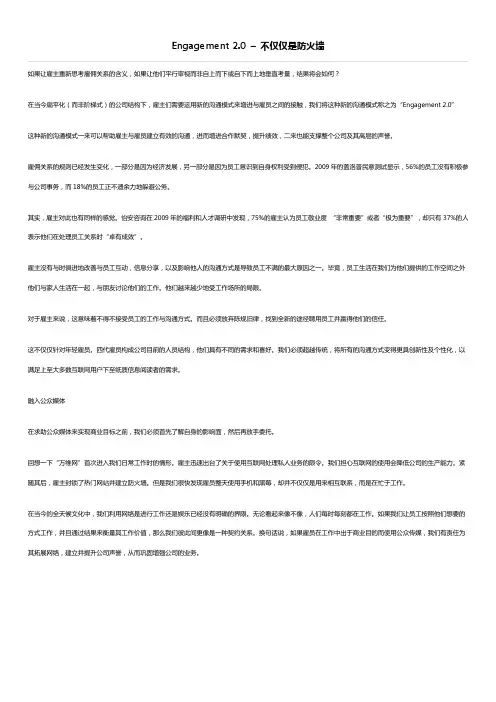
Engagement 2.0 –不仅仅是防火墙如果让雇主重新思考雇佣关系的含义,如果让他们平行审视而非自上而下或自下而上地垂直考量,结果将会如何?在当今扁平化(而非阶梯式)的公司结构下,雇主们需要运用新的沟通模式来增进与雇员之间的接触,我们将这种新的沟通模式称之为“Engagement 2.0”这种新的沟通模式一来可以帮助雇主与雇员建立有效的沟通,进而增进合作默契,提升绩效,二来也能支撑整个公司及其高层的声誉。
雇佣关系的规则已经发生变化,一部分是因为经济发展,另一部分是因为员工意识到自身权利受到侵犯。
2009年的盖洛普民意测试显示,56%的员工没有积极参与公司事务,而18%的员工正不遗余力地躲避公务。
其实,雇主对此也有同样的感觉。
怡安咨询在2009年的福利和人才调研中发现,75%的雇主认为员工敬业度“非常重要”或者“极为重要”,却只有37%的人表示他们在处理员工关系时“卓有成效”。
雇主没有与时俱进地改善与员工互动,信息分享,以及影响他人的沟通方式是导致员工不满的最大原因之一。
毕竟,员工生活在我们为他们提供的工作空间之外,他们与家人生活在一起,与朋友讨论他们的工作。
他们越来越少地受工作场所的局限。
对于雇主来说,这意味着不得不接受员工的工作与沟通方式。
而且必须放弃陈规旧律,找到全新的途径聘用员工并赢得他们的信任。
这不仅仅针对年轻雇员。
四代雇员构成公司目前的人员结构,他们具有不同的需求和喜好。
我们必须超越传统,将所有的沟通方式变得更具创新性及个性化,以满足上至大多数互联网用户下至纸质信息阅读者的需求。
融入公众媒体在求助公众媒体来实现商业目标之前,我们必须首先了解自身的影响面,然后再放手委托。
回想一下“万维网”首次进入我们日常工作时的情形。
雇主迅速出台了关于使用互联网处理私人业务的限令。
我们担心互联网的使用会降低公司的生产能力。
紧随其后,雇主封锁了热门网站并建立防火墙。
但是我们很快发现雇员整天使用手机和黑莓,却并不仅仅是用来相互联系,而是在忙于工作。
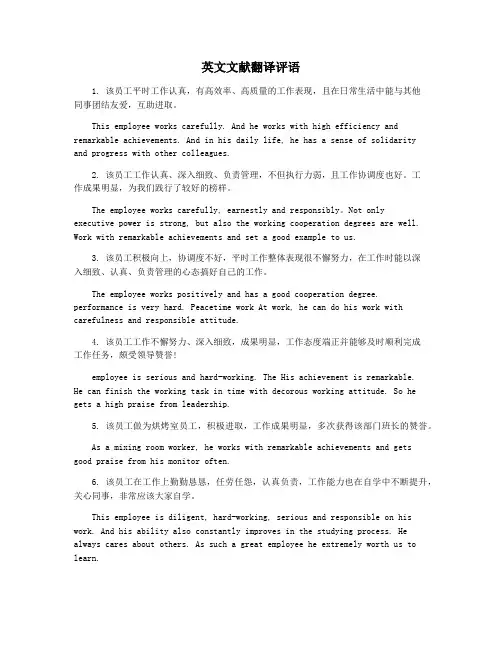
英文文献翻译评语1. 该员工平时工作认真,有高效率、高质量的工作表现,且在日常生活中能与其他同事团结友爱,互助进取。
This employee works carefully. And he works with high efficiency and remarkable achievements. And in his daily life, he has a sense of solidarity and progress with other colleagues.2. 该员工工作认真、深入细致、负责管理,不但执行力弱,且工作协调度也好。
工作成果明显,为我们践行了较好的榜样。
The employee works carefully, earnestly and responsibly。
Not onlyexecutive power is strong, but also the working cooperation degrees are well. Work with remarkable achievements and set a good example to us.3. 该员工积极向上,协调度不好,平时工作整体表现很不懈努力,在工作时能以深入细致、认真、负责管理的心态搞好自己的工作。
The employee works positively and has a good cooperation degree. performance is very hard. Peacetime work At work, he can do his work with carefulness and responsible attitude.4. 该员工工作不懈努力、深入细致,成果明显,工作态度端正并能够及时顺利完成工作任务,颇受领导赞誉!employee is serious and hard-working. The His achievement is remarkable.He can finish the working task in time with decorous working attitude. So he gets a high praise from leadership.5. 该员工做为烘烤室员工,积极进取,工作成果明显,多次获得该部门班长的赞誉。
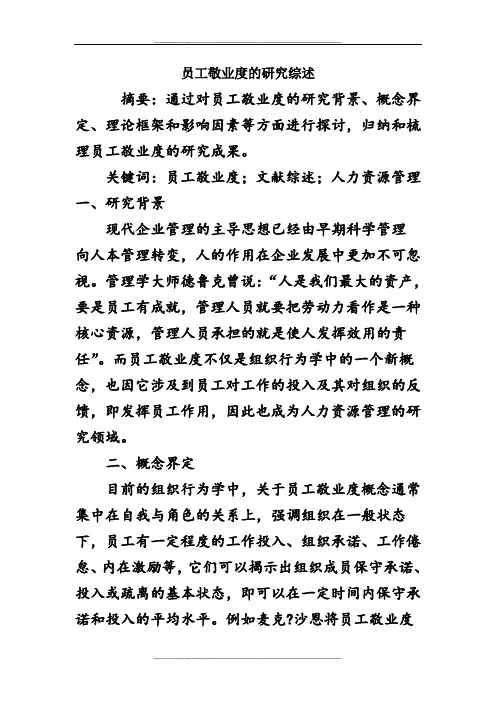
员工敬业度的研究综述摘要:通过对员工敬业度的研究背景、概念界定、理论框架和影响因素等方面进行探讨,归纳和梳理员工敬业度的研究成果。
关键词:员工敬业度;文献综述;人力资源管理一、研究背景现代企业管理的主导思想已经由早期科学管理向人本管理转变,人的作用在企业发展中更加不可忽视。
管理学大师德鲁克曾说:“人是我们最大的资产,要是员工有成就,管理人员就要把劳动力看作是一种核心资源,管理人员承担的就是使人发挥效用的责任”。
而员工敬业度不仅是组织行为学中的一个新概念,也因它涉及到员工对工作的投入及其对组织的反馈,即发挥员工作用,因此也成为人力资源管理的研究领域。
二、概念界定目前的组织行为学中,关于员工敬业度概念通常集中在自我与角色的关系上,强调组织在一般状态下,员工有一定程度的工作投入、组织承诺、工作倦怠、内在激励等,它们可以揭示出组织成员保守承诺、投入或疏离的基本状态,即可以在一定时间内保守承诺和投入的平均水平。
例如麦克?沙恩将员工敬业度定义为:“员工情绪和认知上的激励,对能否完成工作的自我效能,对组织愿景以及自己在其中作用的清晰感知,并且认为自己有资源完成工作的信心”[1]。
Kahn(1990)认为员工敬业度不同于上述角色概念,需要从体力、认知、情感这三个维度去理解[2]。
当员工从组织中获得资源时,他们感到有义务把自我更深入地投入到角色表现中,以作为回报[3]。
员工在工作角色的表现中,分别在生理、认知和情感三个不同层次上进行自我表达。
即员工在完成工作任务时能保持保持高度的生理投入及其相应的行为表现;在认知上能够意识到自己的使命与角色,并保持高度的活跃及唤醒状态;在情感上使自己与同事间保持有意义的联系,并对他人情感变化具有敏感性[4]。
Maslach(2001)根据工作倦怠理论,提出敬业度是与工作倦怠相反的另一个极端。
工作倦怠(job burnout)可以从三个维度来加以定义,即耗竭(exhaustion)、疏离(cynicism)和无效能感(inefficacy)。
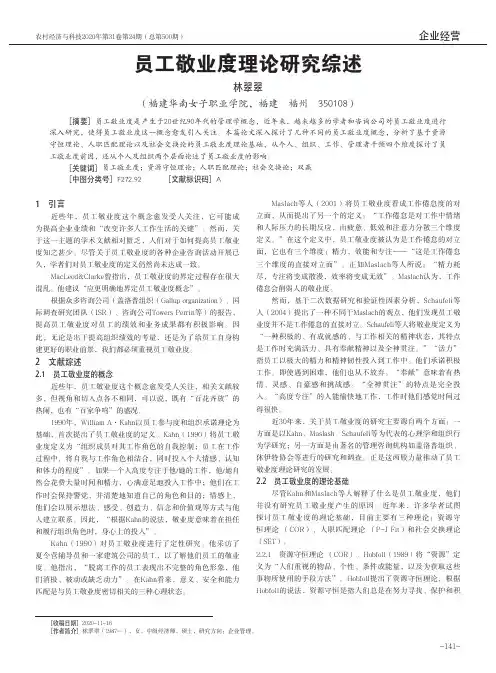
1 引言近些年,员工敬业度这个概念愈发受人关注,它可能成为提高企业业绩和“改变许多人工作生活的关键”。
然而,关于这一主题的学术文献相对匮乏,人们对于如何提高员工敬业度知之甚少。
尽管关于员工敬业度的各种企业咨询活动开展已久,学者们对员工敬业度的定义仍然尚未达成一致。
MacLeod&Clarke曾指出,员工敬业度的界定过程存在很大混乱。
他建议“应更明确地界定员工敬业度概念”。
根据众多咨询公司(盖洛普组织(Gallup organization)、国际调查研究团队(ISR)、咨询公司Towers Perrin等)的报告,提高员工敬业度对员工的绩效和业务成果都有积极影响。
因此,无论是出于提高组织绩效的考量,还是为了给员工自身构建更好的职业前景,我们都必须重视员工敬业度。
2 文献综述2.1 员工敬业度的概念近些年,员工敬业度这个概念愈发受人关注,相关文献较多,但视角和切入点各不相同,可以说,既有“百花齐放”的热闹,也有“百家争鸣”的盛况。
1990年,William A·Kahn以员工参与度和组织承诺理论为基础,首次提出了员工敬业度的定义。
Kahn(1990)将员工敬业度定义为“组织成员对其工作角色的自我控制;员工在工作过程中,将自我与工作角色相结合,同时投入个人情感、认知和体力的程度”。
如果一个人高度专注于他/她的工作,他/她自然会花费大量时间和精力,心满意足地投入工作中;他们在工作时会保持警觉,并清楚地知道自己的角色和目的;情感上,他们会以展示想法、感受、创造力、信念和价值观等方式与他人建立联系。
因此,“根据Kahn的说法,敬业度意味着在担任和履行组织角色时,身心上的投入”。
Kahn(1990)对员工敬业度进行了定性研究。
他采访了夏令营辅导员和一家建筑公司的员工,以了解他们员工的敬业度。
他指出,“脱离工作的员工表现出不完整的角色形象,他们消极、被动或缺乏动力”。
在Kahn看来,意义、安全和能力匹配是与员工敬业度密切相关的三种心理状态。
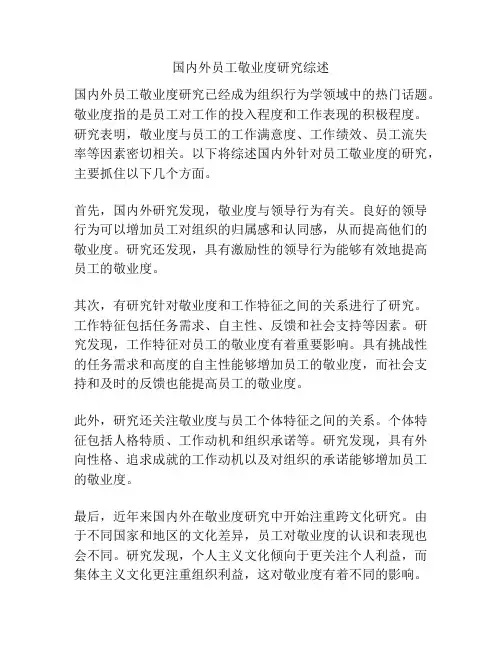
国内外员工敬业度研究综述
国内外员工敬业度研究已经成为组织行为学领域中的热门话题。
敬业度指的是员工对工作的投入程度和工作表现的积极程度。
研究表明,敬业度与员工的工作满意度、工作绩效、员工流失率等因素密切相关。
以下将综述国内外针对员工敬业度的研究,主要抓住以下几个方面。
首先,国内外研究发现,敬业度与领导行为有关。
良好的领导行为可以增加员工对组织的归属感和认同感,从而提高他们的敬业度。
研究还发现,具有激励性的领导行为能够有效地提高员工的敬业度。
其次,有研究针对敬业度和工作特征之间的关系进行了研究。
工作特征包括任务需求、自主性、反馈和社会支持等因素。
研究发现,工作特征对员工的敬业度有着重要影响。
具有挑战性的任务需求和高度的自主性能够增加员工的敬业度,而社会支持和及时的反馈也能提高员工的敬业度。
此外,研究还关注敬业度与员工个体特征之间的关系。
个体特征包括人格特质、工作动机和组织承诺等。
研究发现,具有外向性格、追求成就的工作动机以及对组织的承诺能够增加员工的敬业度。
最后,近年来国内外在敬业度研究中开始注重跨文化研究。
由于不同国家和地区的文化差异,员工对敬业度的认识和表现也会不同。
研究发现,个人主义文化倾向于更关注个人利益,而集体主义文化更注重组织利益,这对敬业度有着不同的影响。
综上所述,国内外对员工敬业度的研究主要从领导行为、工作特征、个体特征以及跨文化等方面展开,为组织提高员工敬业度提供了理论和实践基础。
然而,仍然需要进一步研究来探索其他影响敬业度的因素,并且深入比较不同国家和地区的敬业度状况,以获得更全面的了解。
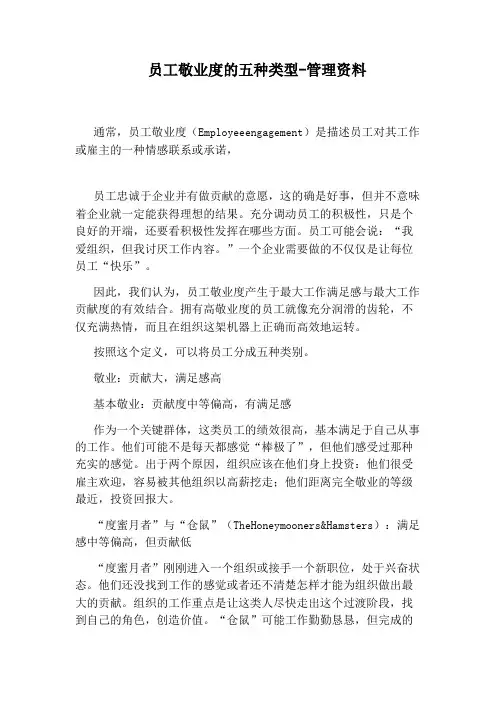
员工敬业度的五种类型-管理资料通常,员工敬业度(Employeeengagement)是描述员工对其工作或雇主的一种情感联系或承诺,员工忠诚于企业并有做贡献的意愿,这的确是好事,但并不意味着企业就一定能获得理想的结果。
充分调动员工的积极性,只是个良好的开端,还要看积极性发挥在哪些方面。
员工可能会说:“我爱组织,但我讨厌工作内容。
”一个企业需要做的不仅仅是让每位员工“快乐”。
因此,我们认为,员工敬业度产生于最大工作满足感与最大工作贡献度的有效结合。
拥有高敬业度的员工就像充分润滑的齿轮,不仅充满热情,而且在组织这架机器上正确而高效地运转。
按照这个定义,可以将员工分成五种类别。
敬业:贡献大,满足感高基本敬业:贡献度中等偏高,有满足感作为一个关键群体,这类员工的绩效很高,基本满足于自己从事的工作。
他们可能不是每天都感觉“棒极了”,但他们感受过那种充实的感觉。
出于两个原因,组织应该在他们身上投资:他们很受雇主欢迎,容易被其他组织以高薪挖走;他们距离完全敬业的等级最近,投资回报大。
“度蜜月者”与“仓鼠”(TheHoneymooners&Hamsters):满足感中等偏高,但贡献低“度蜜月者”刚刚进入一个组织或接手一个新职位,处于兴奋状态。
他们还没找到工作的感觉或者还不清楚怎样才能为组织做出最大的贡献。
组织的工作重点是让这类人尽快走出这个过渡阶段,找到自己的角色,创造价值。
“仓鼠”可能工作勤勤恳恳,但完成的尽是可有可无的任务,对组织的成功贡献寥寥。
还有甚者,把自己隐藏得很好,安于现状,进入“在职退休”状态。
如果组织不解决这些人的问题,那么其他员工就可能越来越不满,或者还得替仓鼠们完成工作,“精神崩溃者”(TheCrash&Burners):贡献度中等偏高,满意度低这些员工是一流的工作者,却未能达到自己心中的个人成功标准和满足感。
他们也许会强烈批评领导者的决策失误,或者毫不留情地指责其他员工拖后腿。
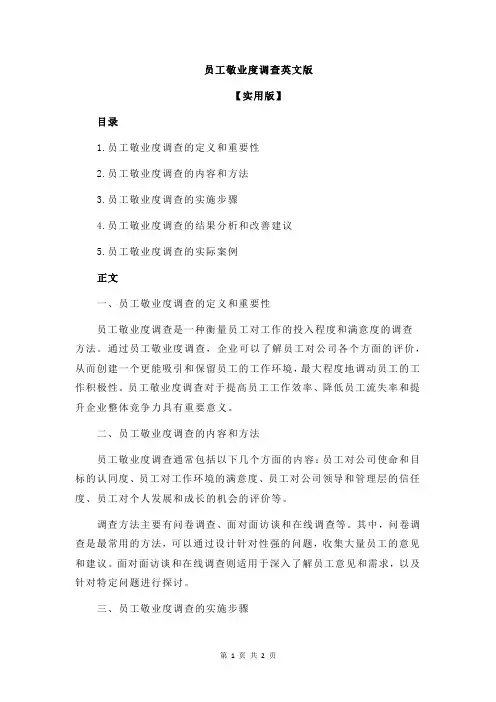
员工敬业度调查英文版【实用版】目录1.员工敬业度调查的定义和重要性2.员工敬业度调查的内容和方法3.员工敬业度调查的实施步骤4.员工敬业度调查的结果分析和改善建议5.员工敬业度调查的实际案例正文一、员工敬业度调查的定义和重要性员工敬业度调查是一种衡量员工对工作的投入程度和满意度的调查方法。
通过员工敬业度调查,企业可以了解员工对公司各个方面的评价,从而创建一个更能吸引和保留员工的工作环境,最大程度地调动员工的工作积极性。
员工敬业度调查对于提高员工工作效率、降低员工流失率和提升企业整体竞争力具有重要意义。
二、员工敬业度调查的内容和方法员工敬业度调查通常包括以下几个方面的内容:员工对公司使命和目标的认同度、员工对工作环境的满意度、员工对公司领导和管理层的信任度、员工对个人发展和成长的机会的评价等。
调查方法主要有问卷调查、面对面访谈和在线调查等。
其中,问卷调查是最常用的方法,可以通过设计针对性强的问题,收集大量员工的意见和建议。
面对面访谈和在线调查则适用于深入了解员工意见和需求,以及针对特定问题进行探讨。
三、员工敬业度调查的实施步骤1.制定调查计划:明确调查目的、调查内容、调查方法和调查时间等。
2.设计调查问卷或访谈提纲:根据调查内容,设计具体、明确、易于理解的问题或访谈提纲。
3.进行调查:按照调查计划,进行问卷发放或面对面访谈。
4.收集和整理数据:整理收集到的数据,进行统计和分析。
5.分析结果:根据数据分析,得出员工敬业度调查结果和分析报告。
6.提出改善建议:针对分析结果,提出针对性的改善建议和措施。
四、员工敬业度调查的结果分析和改善建议根据调查结果,企业可以了解到员工对公司的满意程度和存在的问题。
针对这些问题,企业可以提出改善建议,如提高员工福利待遇、改善工作环境、加强员工培训和提高员工沟通等。
五、员工敬业度调查的实际案例某集团是一家大型重工业集团,为了提高员工敬业度,该集团开展了员工敬业度调查。
通过调查,发现员工对公司的使命和目标认同度低、对个人发展和成长的机会评价不高等问题。
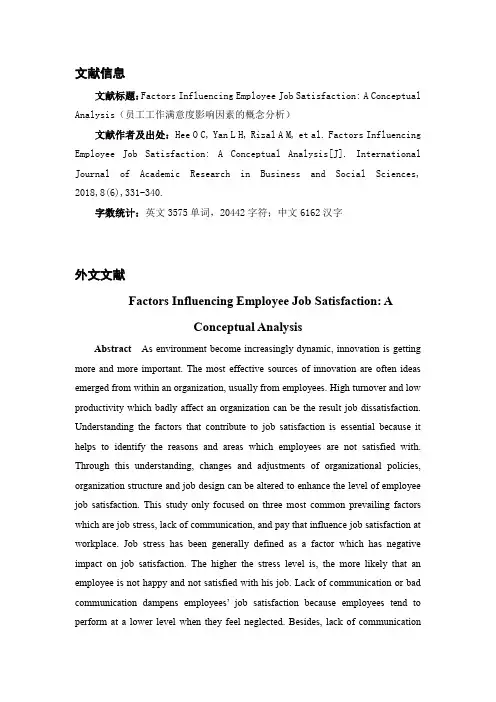
文献信息文献标题:Factors Influencing Employee Job Satisfaction: A Conceptual Analysis(员工工作满意度影响因素的概念分析)文献作者及出处:Hee O C, Yan L H, Rizal A M, et al. Factors Influencing Employee Job Satisfaction: A Conceptual Analysis[J]. International Journal of Academic Research in Business and Social Sciences, 2018,8(6),331-340.字数统计:英文3575单词,20442字符;中文6162汉字外文文献Factors Influencing Employee Job Satisfaction: AConceptual AnalysisAbstract As environment become increasingly dynamic, innovation is getting more and more important. The most effective sources of innovation are often ideas emerged from within an organization, usually from employees. High turnover and low productivity which badly affect an organization can be the result job dissatisfaction. Understanding the factors that contribute to job satisfaction is essential because it helps to identify the reasons and areas which employees are not satisfied with. Through this understanding, changes and adjustments of organizational policies, organization structure and job design can be altered to enhance the level of employee job satisfaction. This study only focused on three most common prevailing factors which are job stress, lack of communication, and pay that influence job satisfaction at workplace. Job stress has been generally defined as a factor which has negative impact on job satisfaction. The higher the stress level is, the more likely that an employee is not happy and not satisfied with his job. Lack of communication or bad communication dampens employees’ job satisfaction because employees tend to perform at a lower level when they feel neglected. Besides, lack of communicationcan also lead to confusion between management and other employees throughout the organization which might incur frustration and resentment. Employees need to feel appreciated, as employees and as human. Employee’s job satisfaction and organizational retention rate can be boosted through a healthy compensation plan with room for bonuses and pay rises. Through the understanding of the factors, organizations can be aware of the symptoms beforehand and take precaution to support and increase the job satisfaction level of employees. In order for an organization to sustain and grow its business, job satisfaction is the long term solution for talent retention and increased performance and productivity.Keywords:Employee Job Satisfaction, Perceived Stress, Lack Of Communication, Pay.IntroductionThe requirements of individuals have been changed due to the increase in quality of life and economic growth in the societies (Tutuncu & Kozak, 2007). Most individuals spend a large part of their lives at work; the change of requirements towards life has also changed their expectations, emotions and feelings towards their jobs (An, Cha, Moon, Ruggiero, & Jang, 2014). There is growing interest towards job satisfaction in organizations as employee job satisfaction is crucial to the success of any business. Improvements of job satisfaction have positive effect on employees’ motivation, performance, and productivity. These are important elements that an organization needs to maintain a competitive workforce in order to deal with challenges arise from the competitive business environment (Marzuki, Permadi, & Sunaryo, 2012). Job satisfaction is also directly related to a lower employee turnover rate, lower absenteeism rate, higher productivity, and better performances which are closely associated to the organization’s cost efficiency for business (Gazioglu & Tansel, 2006). The relationship between job satisfaction and performance was a relatively recent study which indicated that the degree of job satisfaction felt by employees determines their work performance. The study of the relationship between job satisfaction and performance validated the common belief that “a happy worker isa productive worker” (Marzuki, Permadi, & Sunaryo, 2012). In this case, increasing and maintaining the degree of employee job satisfaction should be a priority for every employer (Gregory, 2011). Understanding the factors that contribute to job satisfaction is essential because it helps to identify the reasons and areas which employees are not satisfied with. Through this understanding, changes and adjustments of organizational policies, organization structure and job design can be altered to enhance the level of employee job satisfaction. There are numerous factors that might discourage the employees and lead to job dissatisfaction such as high stress, lack of organizational communication, lack of recognition, limited opportunity for personal and career growth, job characteristics, job security, pay, social relationship within an organization and many more. However, this study only focused on three most common prevailing factors which influence job satisfaction at workplace. The three factors discussed in this study were job stress, lack of communication, and pay. This study intends to establish a conceptual framework which contributes towards talent retention, increased performance and productivity in the dynamic business environment.Job SatisfactionJob satisfaction refers to an employee’s emotional state which covers the complete range of emotions from positive to negative (Zhang, Yao, & Cheong, 2011). Thus, job satisfaction can also be defined as pleasantness or unpleasantness of employees during their work. Besides, job satisfaction can also be described as a positive feeling about a job or job experience (Tutuncu & Kozak, 2007). On the other hand, Fisher (2000) claimed that job satisfaction is a kind of attitude and attitudes generally contain two components which are affective component (feeling and emotional) and cognitive component (comparison, judgment and belief). Job satisfaction can be seen as the result of a chain reaction involving the motivation to satisfy a need. This chain combines several factors or motivators which will influence or induce an individual to perform (Marzuki, Permadi, & Sunaryo, 2012). Early theory of motivation developed by Maslow which is the Maslow’s Hierarchy of Needhad provided ground for further studies on the factors that motivate human. The theory proposed that human motives are based on needs that start in an ascending order from the lowest level to the highest level. The hierarchy moves from lower level needs such as physiological needs, safety and security, social needs to higher level needs such as self-esteem and self-actualization needs. Individuals cannot move to the next higher level until all needs at the lower level are satisfied. When one set of needs is satisfied, it no longer served as a motivator (Marzuki, Permadi, & Sunaryo, 2012). Another theory which contributed to the related literature is the Herzberg’s motivation-hygiene theory. This theory developed by Herzberg is also known as two-factor theory. Herzberg’s motivation-hygiene theory emphasized that satisfaction and dissatisfaction were two distinct variables which were not part of a single continuum. The opposite of job satisfaction is no job satisfaction; similarly the opposite of job dissatisfaction is no job dissatisfaction. Herzberg identified two groups of needs; motivators refer to human needs to achieve and experience psychological growth which are related to job such as recognition for achievement, promotion and etc. Another group which is called hygiene factor is referred to the basic human biological needs such as salary, security, working conditions and etc (Marzuki, Permadi, & Sunaryo, 2012). Hygiene factors determine the extent to which an employee can avoid job dissatisfaction (Zhang, Yao, & Cheong, 2011). In the literature, the importance of job satisfaction is often linked to work performance and organizational productivity or to other important work-related attitudes and behaviors—such as absenteeism, turnover, and reduction of litigation (Zhang, Yao, & Cheong, 2011). Refer to Branham (2005), Gallup studies reported that organizations with higher employee satisfaction achieved 86 percent customer ratings, 76 percent more success in lowering turnover, 44 percent higher profitability and 78 percent safety records. Thus employee happiness at work should be paid attention by the employers. Employee job dissatisfaction can bring disasters to an organization which badly affects the daily operation, such as lack of interest for their responsibilities, tardiness in showing up for work, mild to severe withdrawal from their jobs and diminishing job performance. All these may end up with employees leaving theorganization which cause high employee turnover in the organization (Gregory, 2011). Put in another way, employees who perceive their jobs as satisfactory are more likely to work and stay in the current jobs and in the current organization in the future. Otherwise, employees are more likely to leave and which in turn will influence the performance of the organization and its costs (Tutuncu & Kozak, 2007). Employers are faced with the task to motivate employees and create high job satisfaction among their employees. Thus, understanding of the factors which influence job satisfaction is essential for employers. Through the understanding of the factors, organizations will be able to make relevant changes to prevent employee frustration and low employee job satisfaction (Dawal & Taha, 2006). In this study, job satisfaction has been proposed as the dependent variable in the theoretical framework (Refer to Figure 1). The influence of the three factors (job stress, lack of communication, and pay) to job satisfaction would be discussed in the following sections.Job StressJob stress is generally defined as “an employee’s feelings of job-related hardness, tension, anxiety, frustration, worry, emotional exhaustion, and distress” (Mahfood, Pollock, & Longmire, 2013). Refer to empirical studies (Lambert & Pauline, 2008; Mahfood, Pollock & Longmire, 2013), stress had been identified as one of the major factors that inversely related to job satisfaction. It was stated by Branham (2005) that at least 25 to 50 percent of employees are unable to work at their best due to stress, and this undeniably negatively influence their job satisfaction which subsequently leads to low productivity and high employee turnover. There are many causes which lead to job stress. For instance, insufficient organizational support in supplying tools necessary to perform a job efficiently would generate higher stress level especially when the employees are expected to perform at a required level. Besides, cost cutting practices through eliminating positions and disbursing the workload to other employees also contribute to increased job stress level. Employees would have to take on overbearing workload which erodes their personal time and the unreasonable amount of work would increase employees’ anxiety level tremendously. At the sametime, retrenchment can trigger panic and anxiety among the remaining employees which increase their stress level during work. Untrustworthy employers can be another source of stress. Distrust can be raised from various different situations such as harassment. It becomes difficult to work in an uncomfortable working environment consistently, stress and anxiety increased by trying to avoid troublesome confrontations and situations (Gregory, 2011). It had also been discussed that promotion and career advancement can be one of the leading factors to job stress. The increased stress may come from heavier workloads, extra responsibility and reduced leisure time (Mahfood, Pollock, & Longmire, 2013). Job stress has been generally defined as a factor which has negative impact on job satisfaction in previous literature. The higher the stress level is, the more likely that an employee is not happy and not satisfied with his job. Thus, the following proposition is formulated for this study which job stress has been viewed as an antecedent of job satisfaction:Proposition 1: Job stress will be negatively related to job satisfaction.Lack of CommunicationCommunication can be interpreted as the exchange of information between a sender and a receiver. Communication is a fundamental management activity in every organization because it is crucial for employees to receive correct information regarding to their jobs. Communication has been widely valued in organization today; it has been seen more multidimensional than just message exchange or provide information about people’s work. Communication is about relationships which it acts as the social glue that ties employees within the organization together (Steingrímsdóttir, 2011). Communication channels can be divided into two categories which are formal communication and informal communication. The most popular formal communication ways are face-to-face communication and technical communication. Informal communication is communication stemmed naturally from people’s interactions. People can talk about their feelings, create relationships and discuss any issue that matter to them each time. It is believed that informal communication is the communication which established the actual relationshipsamong people in an organization. However, informal communication tends to increase rumours or carry wrong information within the organization (Steingrímsdóttir, 2011). Right communication channel is vital for an organization. By choosing channels can make a real difference in how the message is received. Different communication channels are suitable and fit for different kinds of information and achieve different objectives (Steingrímsdóttir, 2011). Lack of communication in organization leaves employees feeling disconnected from the organization. Generally this is the result of management personnel who do not know how to relate their employees on a personal or professional level. Lack of communication or bad communication dampens employees’ job satisfaction because employees tend to perform at a lower level when they feel neglected (Gregory, 2011). Besides, lack of communication can also leads to confusion between management and other employees throughout the organization which might incur frustration and resentment. The organizational morale can be negatively affected by gossips and rumours due to lack of communication too. The deteriorating working environment can cause job dissatisfaction and high employee turnover (Ashe-Edmunds, 2014). In an organization, managers should communicate with lower level employees. Managers act as the connection of the organization which will give employees a sense of belongings and worth in the organization. Supervisors should also become the role model to promote friendly relationships with employees in order to achieve a healthier working environment. It is imperative that managers and supervisors respect all the employees, their opinions and their work. Understanding of the organization’s direction and goals and clarification of expectations associated with different positions should be communicated and conveyed to the employees to assist employees in understanding their direct relationships with the organization and how their work affects others’ work (Gregory, 2011). In addition, performance reviews can be utilized as a managerial communication tool because they give administrators an idea of those employees that are contributing to the organization’s success and those who need to work harder. In general, employees may be unaware of their performance measures and have no sense of how they can improve. Without communication through performance reviews, itwould be tough for employees to make any progress in their efficiency which also negatively impact their personal or professional development, and in turn, incur job dissatisfaction (Gregory, 2011). Therefore, in light of the above discussion, it is proposed that:Proposition 2: Lack of communication will be negatively related to job satisfaction.PayCompensation is the total amount of the monetary and non-monetary pay provided to an employee by an employer in return for work performed as required. The monetary pay includes fixed pay which the amount and payment are guaranteed and flexible pay which contains variable pay such as goal-base pay, overtime and etc. Non-monetary pay includes all kinds of employee benefits such as family assistance, recreational opportunities, complementary pension plans, health insurance and etc (Igalens & Roussel, 1999). It was suggested in previous literature (Money & Graham, 1999; Green & Heywood, 2008) that monetary pay is the primary motivator for employee performance and a determinant of job satisfaction. Employees generally prefer their work efforts to be recognized and rewarded thus recognition of an employee’s hard work is essential to his or her job satisfaction. However, too often organizations are more focused on production and revenues, rather than their own employees (Gregory, 2011). By rewarding employees monetarily or non-monetarily as incentive, employees would feel that their hard work and achievements have not gone unnoticed. Employees need to feel appreciated, as employees and as human (Branham, 2005). By linking the money and performance tends to motivate employees to be more productive and hence they would be more willing to work harder towards success (The Chicago School of Professional Psychology, 2012). Through rewarding, employees are more optimistic about future employment in the organization too (Gregory, 2011). It is believed that employee’s job satisfaction and organizational retention rate can be boosted through a healthy compensation plan with room for bonuses and pay rises (The Chicago School of Professional Psychology, 2012).However, organizations should be very prudent in planning of pay structure and should set confidentiality policy for individual employee’s pay amount. Normally organizations choose to underpay those employees who are willing to work hard for minimal pay while to pay more to those who are not willing to work for minimal pay. The pay disparity will eventually lead to great degree of job dissatisfaction when the hard workers realized they are not being paid fairly (Branham, 2005). Refer to the Society of Human Resource Management research report conducted in May 2014; pay has been identified as the most important drivers for job satisfaction by which 60 percent of employees rated compensation/pay as very important and 36 percent rated it as important. Compensation/pay was also claimed as the leading factor of job satisfaction across four generations of employees which are millennial, Generation X, Baby Boomers and Veterans (Miller, 2014). It is noteworthy that there was previous studies indicated that the pay amount or salary amount is not the main determinant for job satisfaction. The comparison of income which employees set up as referential point is more significant in influencing employee job satisfaction. Given the similar qualifications and specifications, if an employee believes that the salary offered in other organization is higher, he or she will be dissatisfied even his or her salary is considered high as compared with the salaries in the organization he or she works in (Al-Zoubi, 2012). According to Miller (2014), more than half of employees feel satisfied if they are paid competitively with the local market. As a result of the empirical studies, it is believed that pay is able to influence the job satisfaction level of employees. Therefore, the following statement is proposed:Proposition 3: Pay will be positively related to job satisfaction.Theoretical FrameworkThere are many empirical studies and literature focused on the topic of job satisfaction. Numerous factors which will influence job satisfaction have been discussed individually. The factors include limited personal and career growth, job characteristics, job security, organizational support, social relationship within organization, relationship with immediate superior and etc. Different factors areassociated with the job satisfaction either positively or negatively. Three most popular factors have been the focus of this study, which are job stress, lack of communication and pay. Job stress, which inversely affects the emotions and feelings of employees at work, is likely to induce job dissatisfaction. Low morale, misunderstanding and reduced job satisfaction can happen if there is lack of communication. On the other hand, the perception of employees that their pay or salary is comparatively or relatively low will instigate employees’ dissatisfaction at work too. By looking at the selected factors, a theoretical framework has been generated to indicate the influence of job stress, lack of communication and pay on job satisfaction. The theoretical framework is depicted in Figure 1.Figure 1: Proposed Theoretical FrameworkResearch ImplicationsWith the changes of the external environment, organization competitiveness is no longer solely relied on the tangible assets, but also numerous intangible assets. As environment become increasingly dynamic, innovation is getting more and more important. The most effective sources of innovation are often ideas emerged from within an organization, usually from employees. Hence an organization’s competitive advantage can be generated through human resources. Job satisfaction was studied in this paper as it is one of the key factors which directly related to employee motivation, employee commitment and productivity and employee turnover rate. An organization can focus on productivity and increased sales if its employees are happy and satisfied with their jobs while its competitors are still struggling to maintain experienced and motivated employees. In reality, organizations are facing the issue of creating high jobsatisfaction among their employees. This study intends to show a better understanding of the factors which emphasizes on job stress, lack of communication and pay, which influence job satisfaction. In terms of practical implications, management and managers are advised to concern about the employee job satisfaction within their organizations. They are encouraged to fully support and commit to policies and activities which can be identified and designed through factors influence job satisfaction in order to stimulate employees’ satisfaction at work such as improvements of working conditions, job training, leadership development and etc. By not overloading the employees, while maintaining a good communication with employees and compensating employees with a reasonable pay according to the jobs and market rate will enhance their job satisfaction. When employees are satisfied with the work they are doing, their jobs are more likely to be an enjoyable and happy experience. With higher job satisfaction, there tends to be higher degree of employee commitment which significantly reduce absenteeism and employee turnover rate which leads to decrease in employee-related costs, meantime increase job performance level which employees are more willing to participate in problem-solving activities and perform activities outside their job scope. In order to sustain the organizational competitiveness, the understanding and changes of policies based on the three most popular factors which contribute to job satisfaction namely job stress, lack of communication and pay are essential.ConclusionThe employment market is heating up and organizations start to worry about losing good talents and struggling to retain them since human resources is one of the vital competitive advantages. Some of the organizations are facing constant high employee turnover which accompanied with unsatisfactory performance and low productivity. High turnover and low productivity are the most obvious indicators of job dissatisfaction. Thus better understanding on the factors which influence job satisfaction is very crucial for all organizations. Through the understanding of the factors, organizations can be aware of the symptoms beforehand and take precautionto support and increase the job satisfaction level of employees. In order for an organization to sustain and grow its business, job satisfaction is the long term solution for talent retention and increased performance and productivity.中文译文员工工作满意度影响因素的概念分析摘要随着环境的不断变化,创新变得越来越重要。
员工敬业度的五种类型通常,员工敬业度(employee engagement)是描述员工对其工作或雇主的一种情感联系或承诺。
例如,美世咨询公司将其定义为“员工对组织的承诺和为组织的成功做出贡献的意愿”。
员工忠诚于企业并有做贡献的意愿,这的确是好事,但并不意味着企业就一定能获得理想的结果。
充分调动员工的积极性,只是个良好的开端,还要看积极性发挥在哪些方面。
员工可能会说:“我爱组织,但我讨厌工作内容。
”一个企业需要做的不仅仅是让每位员工“快乐”。
因此,我们认为,员工敬业度产生于最大工作满足感与最大工作贡献度的有效结合。
拥有高敬业度的员工就像充分润滑的齿轮,不仅充满热情,而且在组织这架机器上正确而高效地运转。
按照这个定义,可以将员工分成五种类别。
敬业:贡献大,满足感高这类员工的个人利益与组织利益一致。
他们全力以赴地为组织的成功贡献自己的力量,并从自己的工作中获取极大的满足感。
他们自觉主动地工作,责任心强。
对于一些招聘电话,他们会礼貌地回绝。
组织需要保护他们的敬业精神,因为随着时间的推移,他们可能会下移到邻近的三个类别,并很有可能损害整体士气与组织的盈利能力。
基本敬业:贡献度中等偏高,有满足感作为一个关键群体,这类员工的绩效很高,基本满足于自己从事的工作。
他们可能不是每天都感觉“棒极了”,但他们感受过那种充实的感觉。
出于两个原因,组织应该在他们身上投资:他们很受雇主欢迎,容易被其他组织以高薪挖走;他们距离完全敬业的等级最近,投资回报大。
“度蜜月者”与“仓鼠”(The Honeymooners &Hamsters):满足感中等偏高,但贡献低“度蜜月者”刚刚进入一个组织或接手一个新职位,处于兴奋状态。
他们还没找到工作的感觉或者还不清楚怎样才能为组织做出最大的贡献。
组织的工作重点是让这类人尽快走出这个过渡阶段,找到自己的角色,创造价值。
“仓鼠”可能工作勤勤恳恳,但完成的尽是可有可无的任务,对组织的成功贡献寥寥。
员工敬业度调研员工敬业度(EmployeeEngagement)很重要,这几乎已经是各大企业公认的事实了。
但当我们热切谈论敬业度时,你是否真的理解她呢,了解它的历史与变化呢?员工敬业是衡量公司绩效卓越的重要条件。
杰克韦尔奇曾说:衡量一个公司稳健性有三个指标,分别是现金流、客户忠诚度和员工敬业度。
到底什么是敬业度呢?01啥是敬业度?敬业度:是反映员工对公司投入的智慧、感情和承诺的程度,最终表现为以下三种行为方式:1、乐于宣传:员工一如既往地向同事、潜在同事,尤其是向客户(现有客户及潜在客户)盛赞自己所在的组织。
2、乐于留:员工强烈希望留在组织之中。
3、乐于努力:员工付出额外的努力并致力于那些能够促成经营成功的工作。
员工敬业度的衡量:1、乐于宣传:如果有机会,我将向公司以外的人员介绍在这里的工作益处;我愿意向正在求职的朋友推荐公司2、乐于留任:我不会轻易离开这家公司;我很少考虑“跳槽”3、乐于努力:公司能够激励我付出额外的努力,以帮助公司取得成功;公司能够激励我每天尽全力工作。
02敬业度调研的价值和作用1、经营状况的预测工具一般满意度调研针对的对象是员工对企业感知,而敬业度调研更关注员工目前和未来的工作状态,并进而从人员管理角度出发预测未来企业经营状况,这有别于传统的财务测算;2、企业管理水平的评价工具目前许多企业已建立起以敬业度调研为核心的下属机构人员管理水平评价工具,并将其成功纳入公司的战略评价体系中3、人力资源管理水平的系统提升工具敬业度调研能够帮助仝业更为深入的了解当前人力资源管理水平,并且通过影响力分析等工具准确定位人力资源提升领域,以实现收入产出的最优化;通过敬业度调研、分析和提升的整个过程帮助提高人力资源团队在组织内的影响力、专业能力以及对企业人员和业务情况的理解程度。
03敬业度逻辑关系04员工敬业度驱动因素1、人员高层领导:员工能否从高管身上看到企业的发展前景管理团队:员工能否从管理团队身上观察到有效的领导技能直接上级:直接上级是否能为员工提供必要的支持,帮助员工取得成功同事:同事间是否互相尊重彼此的想法和感受重视员工:在公司中,员工能否感受到尊重和重视2、全面薪酬薪酬:相对员工对公司的贡献而言,他的薪酬水平是否合理福利:公司提供的福利项目是否可以满足员工的需求认可:对于工作成绩,员工能否获得除薪酬以外的适当肯定3、机遇职业发展机会:员工是否拥有良好的个人成长与职业发展机会学习与发展:公司能否提供必要的培训帮助员工培养重要的技能4、生活质量工作/生活平衡:员工能否在工作与生活间保持适度的平衡5、工作工作任务:员工是否喜欢自己的日常工作资源:公司现有的各项资源(如:技术、工具、系统等)是否有助于员工提高工作效率成就感:员工能否从工作中得到成就感工作流程:公司是否有适当的工作流程(如制定目标和优先次序,项目规划和质量检验),帮助员工有效地开展工作安全:公司的工作环境是否符合安全标准6、政策与操作人力资源管理政策:公司的管理制度能否帮助员工有效地开展工作缋效评估:绩效考核制度能否帮助员工了解自己的优势和不足多样化:公司能否提供开放,容纳个体差异的工作环境7、品牌公司声誉:员工在公司工作是否有自豪感企业文化:员工在工作中是否受到企业文化和企业价值观的熏陶客户导向:公司在客户中是否有良好的声誉So, 员工敬业度=敬业度驱动因素(员工视角)+敬业度行为方式(企业视角)。
employee well being外国文献以下是一些关于员工福祉(employee well-being)的外国文献:1. Adams, S., Gupta, N., & Leidecker, J. K. (2016). Acomprehensive model of employee well-being in workorganizations. Journal of Business Ethics, 2(17), 273-291.这篇文献提出了一个全面的员工福祉模型,包括组织支持、工作满意度、工作与非工作生活平衡等因素对员工福祉的影响进行了研究。
2. Bakker, A. B., & Demerouti, E. (2017). Job demands-resources theory: Taking stock and looking forward. Journal of Occupational Health Psychology, 22(3), 273-285.这篇文献概述了工作需求-资源理论,并讨论了该理论如何与员工福祉相关。
3. Demerouti, E., Bakker, A. B., Nachreiner, F., & Schaufeli, W. B. (2001). The job demands-resources model of burnout. Journal of Applied Psychology, 86(3), 499-512.这篇文献介绍了“工作需求-资源模型”的概念,并探讨这个模型如何与员工福祉以及工作倦怠相关联。
4. Grawitch, M. J., Barber, L. K., & Christensen, M. (2010).Work–family conflict, emotional exhaustion, and employee well-being: A test of the work–family interface model. Journal of Occupational Health Psychology, 15(3), 211-224.这篇文献测试了工作和家庭冲突、情感耗竭与员工福祉之间的关系,验证了工作-家庭接口模型在员工福祉研究中的适用性。
Annotated BibliographyAbraham, S. (2012). Job Satisfaction as an Antecedent to Employee Engagement. SIES Journal of Management, 8(2), pp. 27-36.Abraham (2012) focused on examining the relationship between job satisfaction and employee engagement. In order to test the relationship between the variables, questionnaire survey was hired as the tool to gain primary data from 30 workers. In this academic research, systematic sampling technique was hired as the method to select research samples for data collection. Techniques of statistical analysis including correlation analysis, regression analysis and t-test analysis were employed to analyze the gained primary data from research samples. Based on the analysis results, Abraham (2012) found that job satisfaction as an antecedent that will significantly impact on the increase of employee engagement. Additionally, the results of regression analysis shows that employee engagement will be affected and driven by all kinds of factors, including the nature of job, the recognition of superiors to followers ' work, comparative benefits, teamwork spirit, cross-department cooperation, as well as proper and equal policy of company.This article has higher practical value as this research proves that employee engagement can be increased by improving employee satisfaction. Such finding provides approach to increase the level of employee engagement in organization. However, limitations of this article are also witnessed. Key limitation is use of small scope of research sample to answer research theme. In this research, only 30 workers were used to study for finding out the relationship between employee satisfaction and employee engagement. To some extent, the use of small-scope samples will lower down the convincing and reliability of the research results.The research findings of this research are useful for the current research project because Abraham (2012) proves that employee satisfaction is a key antecedent affecting the level of employee engagement. This could be used toexplain key driver and antecedent of employee engagement. Additionally, the findings also dominate some key factors that will influence the level of employee engagement. Thus, the findings could provide implications for developing employee engagement.Eldor, L., & Vigoda-Gadot, E. (2016). The nature of employee engagement: Rethinking the employee –organization relationship. The International Journal of Human Resource Management, pp1- 27.Eldor and Vigoda-Gadot (2016) has rethought the relationship between employee and organization in order to hence theoretical basis of employee engagement. In this academic article, Eldor and Vigoda-Gadot (2016) have compared and contrasted the conception of employee engagement to other similar conceptions such as psychological contract and psychological empowerment based on theoretical analysis, and have examined whether the contributions of employee empowerment work centrality over psychological contract and psychological empowerment. In order to realize research objectives, questionnaire survey has been adopted as the instrument to gain primary data from 593 workers who were selected from public and private organizations located in Israel. The gained data were analyzed by using statistical analysis technique. Based on the data analysis results, Eldor and Vigoda-Gadot (2016) have found that employee engagement differs from both psychological contract and psychological empowerment. The results suggest that employee engagement shows a higher level of employee activation and mutual exchange simultaneously, which is significant different from psychological contract and psychological empowerment. In addition, the results have also proved that employee engagement will produce significant effect on work centrality.This academic article has provided could provide theoretical foundation for studying employee engagement. In the academic article, the findings are drawn from empirical investigation. Therefore, the research findings of this academic article are convincing as the results are based on objectiveanalysis of statistical data. However, it should be noticed that this academic article has also some limitations. The first limitation is that research samples are limited in organizations located in Israel. Thus, the research findings would be more suitable for explaining the relationship between employee engagement and work centrality in organizations in Israeli. Another limitation is that the article is based on cross-sectional research instead of longitudinal research, which will hamper to examine the cause direction and stable relationship between employee engagement and work centrality.The findings of this academic article will be useful for my research because the findings not only outline the concept of employee engagement, but also prove the importance of employee engagement to organization. For this, the findings of this article can be cited as important evidence to justify why employee engagement is so important to contemporary organizations.Jha, B., & Kumar, A. (2016). Employee Engagement: A Strategic Tool to Enhance Performance. DAWN: Journal For Contemporary Research in Management, 3(2), pp.21- 29.Jha and Kumar (2016) have studied the benefits of employee engagement based on primary and second research. Secondary research was used to collect second information data from various journals, articles, reports, as well as websites to demonstrate knowledge about employee engagement. In terms of primary research, questionnaire survey was employed to gain information data from 100 people in New Delhi area. The questionnaire survey will be conducted through direct approach, mail, and phone. The research results show that employee engagement helps to develop employees 'positive attitudes and behaviors, which in turn motivate employee 's working efficiency and performance, resulting in the improvement of organizational effectiveness and performance.The results of this academic research are credible as the research resultsare generated based on primary and secondary research. To ensure the objectivity of research results, statistical analysis is used to process and analyze the gained primary data. The data analysis results have been represented in graphic form, which visual shows the final conclusion of the academic research. In a sense, this academic article provides theoretical and practical rationale to explain the importance of employee engagement to both employees and organization. However, it should be noticed that there are also some limitations in this academic research. One the one hand, this research only select small-scale sample as the research samples to study the importance of employee engagement. In this research, only 100 samples were selected as the research samples for this research. On the other hand, this research was conducted in New Delhi area. This may cut down the reliability of the research findings.In general, these research findings are useful for my research project as Jha and Kumar (2016) clearly state employee engagement plays an important role in improving the efficiency and performance of both employees and organization. The findings provide empirical evidence to support the notion that employee engagement is very important to organization in today 's business world. Therefore, the usefulness of this academic research to my research project is obvious.Kumar, R., & Sia, S. K. (2012). Employee engagement: Explicating the contribution of work environment. Management and Labour Studies, 37(1),pp.31- 43.Kumar and Sia (2012) study the contribution of eight work environment dimensions including supervisor support, co-worker cohesion, work pressure, task orientation, autonomy, physical comfort, control and clarity to three dimensions of employee engagement including cognitive engagement, emotional engagement, and physical engagement has been examined. To understand the relationship between work environment and employee engagement, questionnairesurvey is hired as the tool to gain primary data from 100 workers from two food processing enterprises in Patiala, Punjab, India. To ensure the representation of research samples, simple random sampling technique is used in this research. The findings show that two work environment dimensions including autonomy and work pressure will significantly contribute to the improvement of emotional and cognitive engagement, and that co-cohesion has positive impacts on physical engagement.To some extent, the research results found by Kumar and Sia (2012) could provide positive implications for Indian organization as the results could help Indian organization to improve employee engagement by improving work environment factors. The results are supported by empirical investigation and statistical analysisso that it is believed that the research results are credible. But, on the other hand, itshould also be noticed that there are some limitations that cannot beignored. The first limitation is that the sample size for this research is quite small. This will negatively lower down the convincing of the research results. On the one other, the representation of research sample is not high. In this research, the total research sample is consisted of 9 female workers and 92 male workers. Uneven gender distribution will cut down the effectiveness of research results to explain the relationship between work environment and employee engagement because different gender employees will have different views. Therefore, the research results may be biased in explaining the impact of work environment variables on employee engagement variables.Generally speaking, the research results found by Kumar and Sia (2012) are useful for the current research project because Kumar and Sia (2012) clearly state some key work environment factors that will influence the level of employee engagement in organization. Therefore, the research results can beused as the evidence to support the notion that the antecedents and drivers of employee engagement within organizations.Megha, S. (2016). A brief review of employee engagement: definition, antecedents and approaches. Clear International Journal of Research in Commerce & Management , 7(6), pp79 –88.Megha (2016) demonstrates employee engagement based on the review of previous literature. To conduct systematic research, an integrated literature review is hired as the method to gain data from previous academic articles. The articles related to the present research theme will be categorized according to themes. By conducting systematic review of previous articles, findings were presented. In terms of definition of engagement, various scholars have defined employee engagement under different protocols. Reviewing various definition of employee engagement, a common idea is that employee engagement is desired condition, and is directly related to work involvement, work enthusiasm and passion, work commitment, and personal effort and energy in workplace. Additionally, the research results also shows different drivers and antecedents of employee engagement, including personal personality and perception, employee emotional experiences and wellbeing, work-life balance, interpersonal relationship within workplace, management style, employee voice, job design, two-way communication, commitment to employee well-being, high-efficient internal cooperation, a focus on development, good quality line management, managers ' visible commitment, as well as human resource policies. Regarding with the approaches for promoting employee engagement, the research results show that previous scholars have proved theoretical framework for organizations to approach employee engagement, including need-satisfying approach proposed by Kahn (1990), burnout-antithesis approach proposed by Maslach et al (2001), work engagement approach proposed by Schaufeli et al (2002), satisfaction-engagement approach proposed by Harter et al (2002), and multidimensional approach proposed by Saks (2006).This research has conducted a systematic and comprehensive review of engagement literature. By conducting systematic review, the results could provide positive theoretical and practical implications for organizations to improve the level of employee engagement in workplace. But, this article has its limitations. a key limitation is that this research searched for employee engagement literature through entering keywords. Consequently, some important employee engagement research will not be included.The findings are useful for my current research as Megha (2016) demonstrate the definition of employee engagement, antecedents and drivers of employee engagement and specific approaches to increase employee engagement. Therefore, the findings can be used to support my research project.Shuck, B., Reio. T.G., & Rocco, T.S. (2011). Employee engagement: an examination of antecedent and outcome variables. Human Resource Development International. 14(4), pp. 427-445 .This article investigates the impact of job fit, psychological climate, affective commitment on employee engagement, and in the meantime discuss the positive implications of employee engagement. This research hired aninternet-based self-report survey to gain data from 283 heterogeneous research samples. After the data were collected, SPSS statistics tool was used to process the data for testing the relationship between research variables. The results show that job fit, psychological climate, andaffective commitment are three key antecedences of increasing employee engagement. In addition, the results also demonstrate the improvement of employee engagement helps to reduce employees ' turnover intention.The findings of this article are persuasive because the findings were generated through empirical investigation. In this article, the conclusion is distilled from the analysis of objectively quantitative data. But,limitations of this article also exist. This research selected heterogeneous research samples from all kinds of organizations that are attached to acertain association. This limits the general applicability of the research findings in different associations. Additionally, the findings of this research were generated from self-report survey. Under this condition, the researcher failed in controlling the authenticity of sampling data, which may result in biased results.Generally speaking, this academic article is useful source to support my research project. This research has conducted empirical investigation and has proved that significant impact of job fit, psychological climate, affective commitment on employee engagement. Therefore, the findings can be used to illustrate some drivers and antecedents of increasing the level of employee engagement within organizations. Additionally, the findings also prove that employee engagement helps to increase discretionary effort, and to reduce employees 'turnover intention. Therefore, the findings can be used to prove the importance of employee engagement to organizations.。